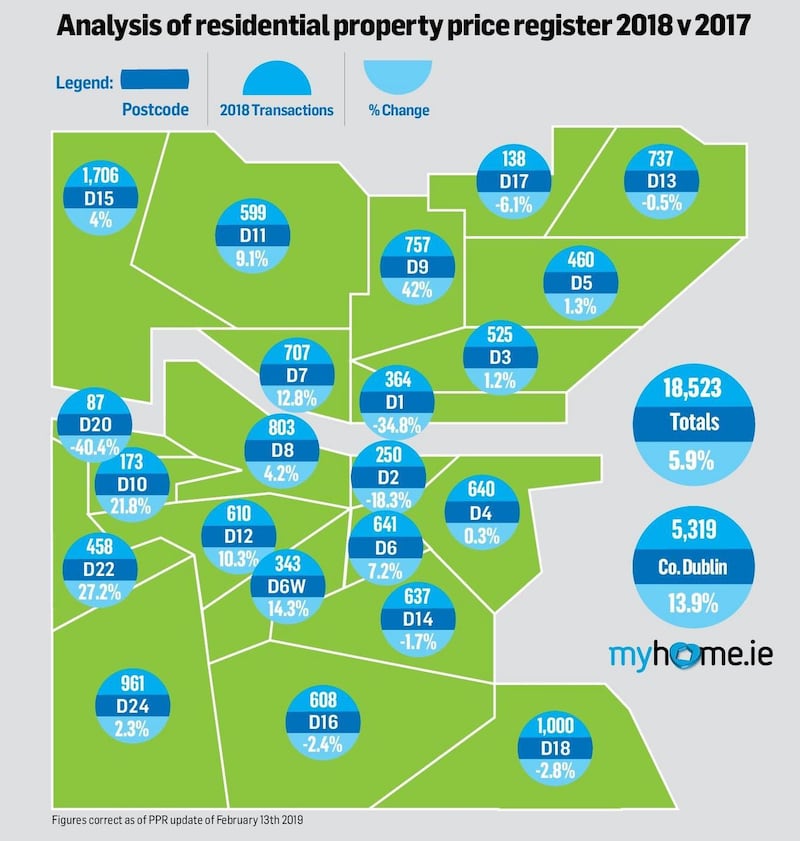The number of house sales in Dublin rose by 5.9 per cent in 2018, with the total value of transactions for the year estimated at €8.7 billion, representing a 17.7 per cent increase on 2017.
The figures, compiled by property website MyHome.ie, are based on analysis of house sale figures on the Property Price Register, where the number of house sales rose from 17,491 in 2017 to 18,253 last year.

Despite the overall increase in the number of houses sold, transactions fell in eight Dublin postcodes, with the sharpest falls recorded in Dublin 1 (down 35 per cent), Dublin 2 (down 18 per cent) and Dublin 20 (down 40 per cent). These falls were attributed to the sale of a number of large multi-unit developments in these areas in 2017. The emerging build-to-rent sector, where entire apartment blocks sell to large institutional investors in one-off transactions, will also have impacted on multi-unit sales in the city centre.
For the second year running Dublin 15 topped the ranking, recording the largest numbers of sales for the year at 1,706 (up 4 per cent from 1,640 transactions in 2017). It was followed by Dublin 18 with 1,000 sales (down 2.8 per cent) and Dublin 24 with 961 sales (up 2.3 per cent). Major new homes developments will have accounted for the bulk of transactions in these areas, including ongoing schemes at Hansfield in Clonsilla and Royal Canal Park in Dublin 15, Clay Farm in Leopardstown, Dublin 18, and Elder Heath in Tallaght, Dublin 24.
‘Supply shortages’
MyHome managing director Angela Keegan said it was the second year running that these three postcodes had recorded the highest number of sales in Dublin. "In light of current supply shortages, it is positive to see new developments coming to the market. However, the downside is that the city is sprawling out beyond the M50 at an alarming rate and that raises questions around public transportation policy, commute times and the kind of city we want to live in.
“We believe we need to look at building higher in certain parts of the city and to providing incentives to build in other towns and cities which haven’t benefited from the economic recovery.”
The postcodes that saw the biggest increases in numbers of transactions were Dublin 9, where sales rose 42 per cent, Dublin 22 (up 27 per cent) and Dublin 10 (up 22 per cent). One of the main reasons for the increase in Dublin 9 was the sale of 75 individual apartments in Northwood Green in Santry and the sale of 65 units in the Grace Park Wood development in Drumcondra.
‘Value of transactions’
While Dublin 8 showed a relatively modest 4.2 per cent increase in transactions, from 771 sales in 2017 to 803 sales in 2018, the value of those transactions increased by 122 per cent. This again demonstrates the impact of a couple of big one-off multi-unit sales: 2 Cannon House, Clancy Quay sold for €139 million and Foley House, also on Clancy Quay, sold for €31 million.
While Dublin sales rose almost 6 per cent year-on-year, Keegan noted that the rate of increase has slowed. In 2017 transactions fell in just four postcodes; last year they fell in eight. The 18 per cent increase in the overall value of Dublin sales is driven by the rising number of new developments.
“It’s interesting to see the areas which have seen the biggest increases. In Dublin 9 it’s areas like Santry, Ballymun, Beaumont and Drumcondra which are driving sales, in Dublin 22 it’s Clondalkin and Liffey Valley, while in Dublin 10 it’s Ballyfermot and Cherry Orchard. While these areas might not always have been in demand, their location and proximity to the city are making them increasingly attractive.”












